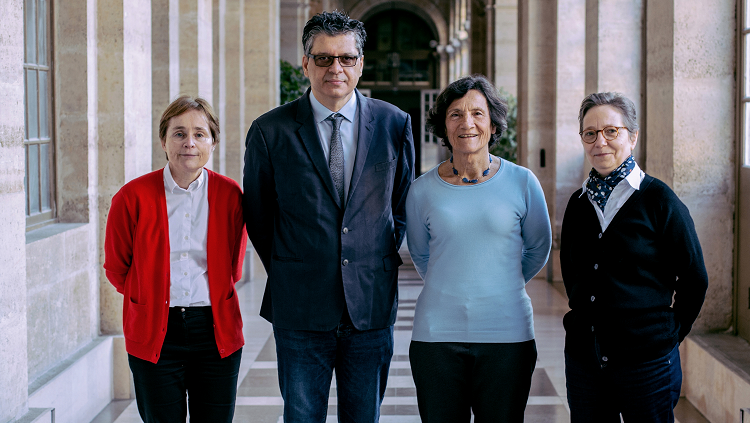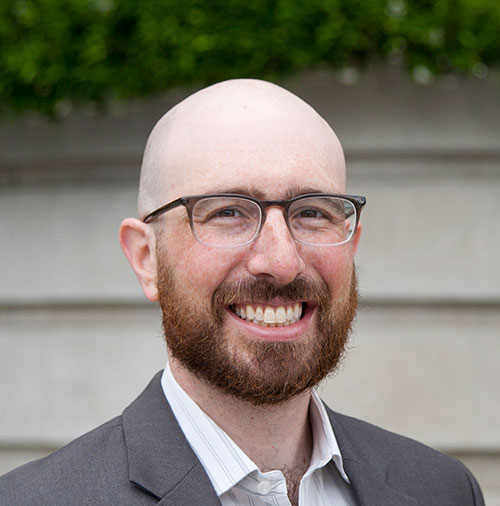The Discovery of CADASIL
- Published3 Apr 2019
- Author Levi Gadye
- Source BrainFacts/SfN

It was 1976. The patient, a man in his 50s, had arrived at the University of Paris for treatment of a minor stroke. Surprisingly, a CT scan traced the stroke to the small, rather than the large, arteries of the brain, but the man was otherwise healthy.
Absent any risk factors, the diagnosis was unclear. The patient’s doctors had to settle on a diagnosis of Binswanger’s disease, a disease normally caused by hypertension (high blood pressure) and old age.
Marie-Germaine Bousser, an assistant neurologist assigned to the case, wasn’t convinced.
Despite her skepticism, though, the most she could do was enroll the patient in a preventative trial with aspirin, and keep an eye on him.
As the years went on, the man developed dementia, and the mystery of his condition continued to perplex Bousser.
“Every time I received new residents to train, I told them, ‘I have this unusual patient,’” she recounted, hoping to spark interest in a research project. “It went on for years, until ten years later I saw his two children, then in their 30s, and they had each already had minor strokes.”
Unlike most stroke patients, this father and his children suffered from an inherited disease predisposing them to suffer numerous minor strokes early in life. These “mini” strokes weren’t initially as devastating as the strokes commonly seen in elderly patients, but as the father’s case showed, they could result in more severe problems, like dementia, over time.
Armed with three examples of unusual, familial stroke, Bousser now managed to capture the attention of Elisabeth Tournier-Lasserve, a fellow neurologist with a growing interest in the research side of the field.
Thanks to the efforts of Bousser, Tournier-Lasserve, Anne Joutel, and Hugues Chabriat, we now know that this disease, dubbed CADASIL, is the most common inherited stroke disorder. And, it is caused by mutations to a single gene. Because of this direct relationship of CADASIL to a mutation, scientists today can study mouse models of heritable stroke.
For their contributions to both neurology and neuroscience, the group was recently awarded the prestigious Brain Prize by the Lundbeck Foundation. Levi Gadye spoke with Bousser and Tournier-Lasserve to learn more about CADASIL and its implications for understanding and treating stroke.
What is CADASIL and how does it differ from other types of stroke?
CADASIL describes the hallmarks of the disease: cerebral autosomal dominant arteriopathy with subcortical infarcts and leukoencephalopathy. “Cerebral autosomal dominant arteriopathy” refers to a disease of the arteries of the brain resulting from a dominant chromosomal mutation in other words, caused by a mutation on just one of two chromosomes. “Subcortical infarcts” refers to the death of tissue deep within the brain thanks to numerous blockages — strokes — in small arteries. Finally, “leukoencephalopathy” refers to the loss of white matter — nerve fibers — in the brain, the result of these chronic strokes.
Many types of stroke are caused by hypertension, which leads to the blockage of small arteries in the brain; this is known as cerebral small vessel disease. In CADASIL, mutations in the Notch3 gene lead to pieces of Notch3 protein progressively clumping up in small arteries. Stroke is typically a disease of old age, but CADASIL typically emerges before the age of 50, according to Tournier-Lasserve. However, many of the features of CADASIL resemble small vessel disease, making CADASIL among the best-understood models for this common condition.
How was CADASIL discovered?
In 1990, Bousser and Tournier-Lasserve began a research collaboration in earnest. Thankfully, the extended family of those first three related patients, who all lived in small villages in western France, were more than willing to participate in the study, in Paris, in the hopes of uncovering the cause of this yet-to-be-named disease.
In a 1991 paper, Bousser and Tournier-Lasserve argued that they had identified a novel and heritable disease on the basis of neurological symptoms and anomalies in brain MRI scans that were present in nearly half of 45 related family members. But the researchers still needed to identify the gene that was causing the condition.
Within a few years, Bousser and Tournier-Lasserve had successfully mapped the responsible gene to human chromosome 19. Bousser coined the term CADASIL, and in 1993, they announced their landmark findings — few diseases had ever been traced as definitively to mutations in a single gene.
Soon, the scope of their collaboration deepened. Bousser and Touriner-Lasserve recruited 32 additional French families with CADASIL to participate in the study, as well as two additional young neurologists to lend their hands to the research effort.
Tournier-Lasserve welcomed Anne Joutel, who had recently completed a residency with Bousser, into her lab, to shift gears into the basic sciences and identify this mutation, at a time when scientists had just begun to trace inherited diseases to mutations in the human genome.
Hugues Chabriat, who had also trained with Bousser, became the group’s expert on the clinical aspects of CADASIL, honing the criteria for identifying the disorder using MRI.
Joutel and Tournier-Lasserve subsequently identified the responsible gene as Notch3, a gene that had previously only been studied in fruit flies, sparking numerous lines of scientific inquiry that continue to this day.
What are the risk factors for CADASIL?
Because CADASIL is autosomal dominant, it affects all individuals who inherit just one copy of the mutated Notch3 gene from a parent. However, smoking, a risk factor for stroke in general, greatly exacerbates CADASIL, as shown by Chabriat, speeding the rate of strokes and the pace of cognitive decline in affected individuals. “Smoking should be really avoided for patients with CADASIL, more so than other stroke patients,” said Tournier-Lasserve.
Why is CADASIL under- or misdiagnosed?
Unlike the strokes that affect older individuals, CADASIL first affects young individuals in subtle ways, complicating diagnosis.
“Stroke is supposed to be something very sudden, but we have shown that it’s a very long process before any symptoms of CADASIL arrive,” said Bousser. “In half the patients, the first symptom is attacks of migraine with aura.”
Luckily, Tournier-Lasserve and Joutel developed a simple genetic test to determine whether a patient, perhaps suffering from a migraine or a minor stroke, has a CADASIL mutation. Though there is no cure for CADASIL, securing a definitive diagnosis can ensure that patients receive the proper care when another stroke inevitably occurs.
“Before we identified the gene, 30 percent of the patients with CADASIL were being diagnosed with multiple sclerosis,” said Tournier-Lasserve. “This can be very counterproductive, because misdiagnosed patients might have to take immunosuppressant treatments, which have severe side effects, while others may be improperly diagnosed with psychiatric disorders and placed into psychiatric facilities.”
How has the study of CADASIL benefited neurology and neuroscience?
Cerebrovascular disease (CVD) — a term that encompasses stroke and CADASIL — can be very difficult to model, due to its diversity of causes and symptoms. CADASIL resembles a major category of CVDs, known as small vessel disease, but has a singular and known cause, making it a “clean” model of small vessel disease, according to Bousser.
For example, the first and only Notch3 mouse model of CADASIL was developed by Joutel, who committed herself fully to basic research in the 1990s. This animal model has enabled Joutel to precisely define the changes in small blood vessels, caused by mutated Notch3 proteins, that lead to stroke and dementia in the absence of hypertension.
Chabriat has shown that while changes to white matter may be the most obvious anomalies found on MRI scans of CADASIL patients, these changes vary widely, and aren’t predictive of which patients will experience dementia. In fact, it is the more subtle subcortical infarcts, caused by miniature strokes in small blood vessels, that appear to herald cognitive decline.
Today, Bousser is retired; Tournier-Lasserve studies other inherited CVDs that resemble CADASIL; Joutel runs her own research lab; and Chabriat continues to work on the relationship between brain defects and cognitive decline.
“At the beginning we were all neurologists, and all of us had seen patients and how bad the disease really was. This was the cement that bound us together and enabled us to pursue this research for so long,” said Bousser. “But we were also so lucky with this remarkable family, and without this first family there would be no CADASIL story. We all became friends and they are still involved in our patient organization.”
References
Baron-Menguy, C., Domenga-Denier, V., Ghezali, L., Faraci, F. M., & Joutel, A. (2016). Increased Notch3 Activity Mediates Pathological Changes in Structure of Cerebral Arteries. Hypertension (Dallas, Tex.: 1979), 69(1), 60–70. doi:10.1161/HYPERTENSIONAHA.116.08015
Joutel, A., Corpechot, C., Ducros, A., Vahedi, K., Chabriat, H., Mouton, P., … Tournier-Lasserve, E. (1996). Notch3 mutations in CADASIL, a hereditary adult-onset condition causing stroke and dementia. Nature, 383(6602), 707–710. doi:10.1038/383707a0
Tournier-Lasserve, E., Iba-Zizen, M. T., Romero, N., & Bousser, M. G. (1991). Autosomal dominant syndrome with strokelike episodes and leukoencephalopathy. Stroke, 22(10), 1297–1302. doi: 10.1161/01.STR.22.10.1297
Tournier-Lasserve, E., Joutel, A., Melki, J., Weissenbach, J., Lathrop, G. M., Chabriat, H., … Bousser, M. G. (1993). Cerebral autosomal dominant arteriopathy with subcortical infarcts and leukoencephalopathy maps to chromosome 19q12. Nature Genetics, 3(3), 256–259. doi: 10.1038/ng0393-256
BrainFacts.org welcomes all your brain-related questions.
Every month, we choose one reader question and get an answer from a top neuroscientist. Always been curious about something?







